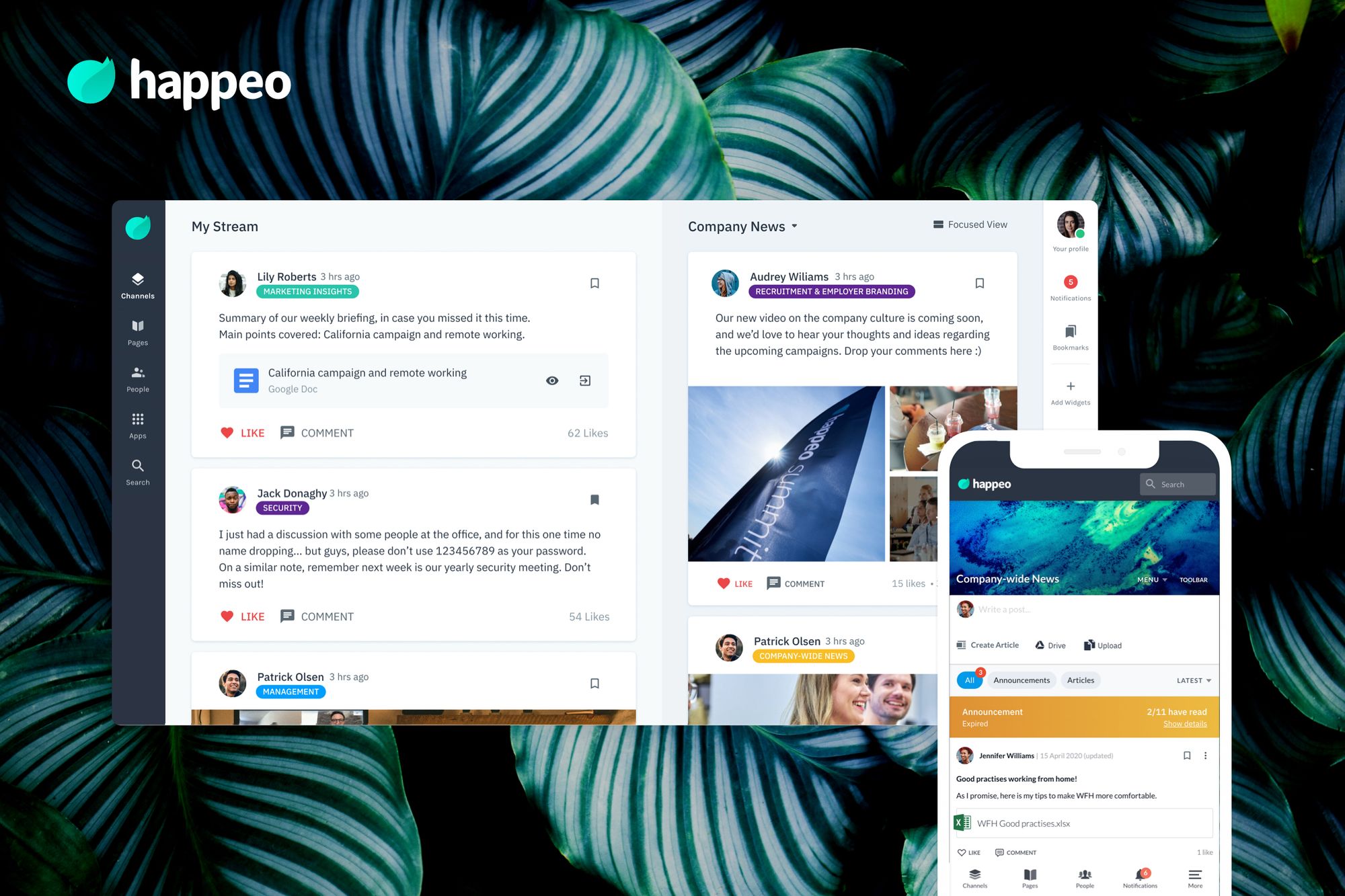Six Best Practices For SaaS International Expansion | Happeo.com
Happeo's CEO Perttu Ojansuu exemplifies six best practices that every other SaaS CEO seeking international success can learn from.

Perttu Ojansuu talks about SaaS international expansion at Happeo.com.
Having authored a number of case studies on successful global expansion, we were planning to add what we thought would be a case study for a Software as a Service company’s international expansion. But we were so impressed, we changed from a “case study” to a set of best practices for SaaS international expansion. To date, we can’t find anyone who has done as much right in international expansion of a SaaS company as Happeo.
If you’re wondering if we’re alone in our assessment, we’d like to point out that they have recently closed a 12M growth funding round. In part, to fund their continued international expansion.
Happeo’s global mindset actually made it difficult to deconstruct their story. Most startups or online businesses start out local, then step into another country.
They either do this in a push or pull fashion. Pull - meaning a SaaS company is pulled into a market by initial customers. Push - meaning they push into a new market as a conscious choice. And you can often trace that expansion to a discrete series of steps and actions, laid out in a sequential timeline. (Or at least arranged that way by their PR people.)
Happeo appeared to simultaneously grow their business with a unique mix of servicing local customers, while at the same time, keeping customers outside their initial territory in their plans.
OnGlobal Opinion: We think that Happeo’s Finnish-born CEO Perttu Ojansuu, is an all-too-rare breed of European entrepreneur that blends building a startup that is grounded locally with a mindset to expand globally. Best practices for SaaS international expansion can only be found if they are first modelled by the leadership team. Perhaps that’s why Finland is responsible for 10% of global startup exits.
We could not trace a specific timeline from our interview, nor construct a playbook of steps that other SaaS companies could follow. (Although we’re inspired to try both in a follow-up piece!) So instead, we’ve grouped Happeo’s attitudes and actions into a collection of what we’re calling best practices for SaaS international expansion.
Best Practice #1: Ensure you're working on a large, global problem.
Happeo started life with the unfair advantage of being born inside another company. Gapps was a leading reseller in Finland focused on bringing the power of G Suite to enterprise customers. So the founders of Happeo had the advantage of a large number of established customers to draw into conversations.
And in those conversations with customers they found a large, global problem. They identified that internal networks of companies, called Intranets, were using a large number of different software programs to provide information to their employees. They wanted to fix that. “We wanted to build a platform which would work as the core hub and knowledge base for these large organizations so they can yet again benefit from the economies of scale.” said Perttu.
Extrapolate that local problem, and you have a potential problem that exists in every other company globally. That’s a big addressable market. That checks off both big and global in our first best practice for SaaS international expansion.
Best Practice #2: Involve international customers in your initial product plans.
Happeo started the conversation with their Finish customers. But they moved quickly into the larger regional market of the Nordics (Denmark, Finland, Iceland, Norway and Sweden). They pulled in companies who were linked by their common language of communication -- English. These turned into reference customers. But, more importantly, helped them understand their sales cycle time. Something that is critical to understand when assessing a new market.
OnGlobal Opinion: Time to revenue is one of our three key challenges in evaluating an entry into a new market. It's not just the amount of sales, but the time it takes to ramp them.
Best Practice #3: Establish if a channel exists, or can be built out, to your global customers.
Early in their company’s life, they brought into their discussions the Google Cloud Partners (G Suite Resellers) who might be interested in their product. These partners in turn brought their customers into the discussions, forming a “triangle of trust” that allowed Happeo to identify where there was demand for their products. This was particularly successful in France and Italy. Happeo complimented those discussions with follow-up discovery calls with other customers in other countries. Happeo used the Google Cloud Partners as a ready-made channel to a global customer base.
OnGlobal Opinion: Starting life as Gapps, and growing to become a leading Finnish Google Cloud Partner, using the partner network would have been obvious to the founding team. But global channels are not obvious. It’s frequently said that SaaS companies can scale globally -- we think that is a dangerous half truth. A SaaS company cannot scale globally unless they can turn unaware prospects into customers on a global scale. And that means a global channel to potential new customers. When considering a SaaS international expansion, channels are as important as products. Here Happeo had a built-in best practice from their early life.
Best Practice #4: Use Data to Determine the Global Market Size
Being data-driven is a day-to-day practice in most SaaS companies. But when you’re launching a new product where do you go to find that data? For Happeo, this was more easily said than done. The solution was two-fold: Interview current SaaS companies that were working in the same space. And interviewing the cloud resellers who provided them with market sizing information.
CEO Perttu Ojansuu readily admitted that this information was not public and needed to be pulled together from multiple resources. And that they were indebted to kind people who made introductions to a few major vendors who shared information and data on the size of the market. Perttu said that would not have been possible without great introductions from others.
OnGlobal Opinion: Perttu highlights a challenge we’re seeing with international expansion. How do you size the market? We don’t recommend using macro economic numbers like GDP. But filling the gap between economic indicators and sizing the number of potential customers seems to be a struggle. Particularly when you’re developing a new service that straddles two mature industries. See our OnGlobal case study of Marley Spoon’s international expansion.
Best Practice #5: Launch with a “Go Global or Go Home” Mindset
Few European startups would think of launching their company in the US, but that’s exactly what Happeo did. Their mindset from the start was “Go Global or Go Home”. While they were still in Gapps they launched their new product at a Google event in Las Vegas. They rented out the entire space at Madame Tussauds and invited guests by sending custom-made chocolates as invitations. The launch event made such a big impact, attendees told them they thought it was Google that was doing the launching. Not Happeo! That’s how successful they were.
Perttu told us that they couldn’t afford to leave the US until later. The US was half of Google’s market presence, with the other half in Europe, APAC and Latin America. So obviously launching in the US was the best and biggest starting point. It also drives home the message to investors and other stakeholders that they were doing more than talking about addressing the US market.
OnGlobal Opinion: In fairness to other startups that harbour global aspirations, this US-based launch would probably not have been possible if Perttu hadn’t taken advantage of launching from within an existing company. Undoubtedly they could draw both resources and customers for their launch event. Starting within another company was a unique advantage in executing the launch. But it was the mindset, not the glitzy launch event, that catches our attention and highlights launching globally as a SaaS international expansion best practice.
Best Practice #6: Hire staff experienced in a new market, but start them locally.
Embarking on a SaaS international expansion eventually means hiring staff with experience in that local market. Happeo hired staff who had not only been part of a successful SaaS startup, but had experience with the international markets that were important to them. But they didn’t overextend themselves to hiring and locating staff in those markets. Preferring instead to have their first few international hires work from their European offices. According to Perttu there is a lot of great talent who have moved from North America to Europe and vice versa. He did mention that the 6 hour time difference is obviously something to deal with, but it’s still possible to sell internationally while keeping the staff local.
We’ll be watching Happeo’s execution, but their global mindset, world-spanning problem and recent funding for international growth, indicates they are well on the way to increasing their 507 m2 of world takeover.
Do you want to tell your story to OnGlobal? Contact us to tell us why.
Disclosure: We provided Perttu Ojansuu and the team at Happeo with an advance copy of this article.
OnGlobal Opinion: The interpretation, adaptation and comment on the named facts are the sole responsibility of OnGlobal.co. Final editorial content is the responsibility of OnGlobal.co -- a project of Sojourner Assay B.V.
